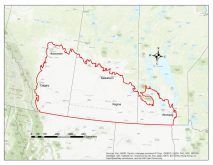“It could have been an absolute nightmare.”
– IAN WISHART, KAP
In Oct. 2008, a Keystone Agricultural Producers council meeting was startled to hear farmers in southwestern Manitoba were getting letters from the province saying they would need licences to drain water from their land.
The reason was Section 3(1) (c) of The Water Rights Act, which stipulated, “No person shall control water or construct, establish, operate or maintain any water control works unless he or she holds a valid and subsisting licence to do so.”
Read Also

Mazergroup’s Bob Mazer dies
Mazergroup’s Bob Mazer, who helped grow his family’s company into a string of farm equipment dealerships and the main dealer for New Holland machinery in Saskatchewan and Manitoba, died July 6 from cancer.
Previously, minor water control works, such as existing onfarm drains, were considered maintenance and exempt from the legislation. But two developments changed that.
NO EXEMPTIONS
One was an April 2008 provincial ombudsman’s report saying there were no legal grounds for exemptions from the act.
The other was a recommendation from the Lake Winnipeg Stewardship Board that all water control works be licensed.
The province also knew some landowners were building major water control projects (e. g., dams) under the guise of maintenance.
So Manitoba Water Stewardship made a decision: no more exemptions. All works, major or minor, would require licences. That included on-farm drains.
KAP was deeply concerned, not just at the ruling itself but by the red tape involved.
There are over 250,000 quarter sections of farmland in Manitoba. Sometimes one quarter has over a dozen small man-made drains. Many have to be maintained each year. Getting a licence for each one is impractical. Besides, obtaining one could take six to eight weeks when many drainage projects needed to be done right away.
MORE WORKABLE
So KAP lobbied government to make the plan more workable.
In the fall of 2009, after discussion with KAP and other stakeholder groups, Water Stewardship announced policies and procedures for authorizing minor water control works.
Such works would still require licences. But once issued, they would not have to be renewed.
Department officers would assess applications, verify that the works were indeed minor and issue authorizations in perpetuity.
In most cases, that meant applying for a licence and paying a fee only once. Projects could be grouped together instead of being treated individually. Landowners would have to submit just a single application per parcel of land instead of one for each drainage project. The fee would be $25.
Today, while not exactly thrilled about having to pay to drain their own water, farmers are grateful the province adopted a softer approach, said Ian Wishart, KAP president.
“It could have been an absolute nightmare,” Wishart said.
GOOD RESPONSE
The response from landowners to the new policy has been “pretty good,” said Perry Stonehouse, Water Stewardship’s manager of water control works and drainage licensing.
The system has been streamlined to approve projects as quickly as possible, Stonehouse said.
Once an application is received, water resource officers go to the site to verify it. Projects are approved and licences issued if excavation is no deeper than one foot and there are no negative impacts to other lands, including wetlands.
Stonehouse said most onfarm drainages follow the same general path year after year, so there’s no need to regularly reapprove them for maintenance. Only if projects take a new direction will a licence have to be revised or reissued.
Over 300 minor water control works have been approved since the new policy took effect in Sept. 2009, said Stonehouse. Water Stewardship has hired 14 new staff to administer the program, with regional offices in Brandon and Stonewall.
TURNAROUND TIME
The turnaround time for approvals is normally two weeks. Emergency approvals, when necessary, can be a lot quicker, Stonehouse said. Recently, in western Manitoba, heavy rain filled a wetland, causing it to overflow and flood an access road to a farmstead. Provincial authorization for the local municipality to start pumping came within a few days.
Drainage is a two-edged sword and cuts both ways. Wishart said he gets as many phone calls from farmers complaining about damage from upstream drainage as he does from farmers who complain they’re not allowed to drain.
For that reason, KAP does not oppose the principle of licensing drainage projects, he said.
The program is still new and bugs are still being ironed out. Wishart said one problem is that field officers aren’t always consistent in approving applications. Some, especially from conservation backgrounds, lean more toward preserving habitat than some farmers would like, he said.
Stonehouse said most landowners comply readily once they realize the procedure isn’t onorous.
But Wishart said he knows of at least three cases in which charges have been laid for illegal drainage. One of those charged is a municipality. [email protected]


















